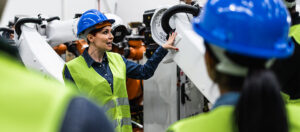By Deborah Jeanne Sergeant
Industry should continue investing in technology, talent, experts say

Manufacturing represents an important part of New York state’s economy. The industry accounts for 4.45% of the total output i-n the state and employs 4.58% of the workforce, according to The National Association of Manufacturers.
In 2018, New York’s total output from manufacturing was $74.58 billion and the state boasted about 444,000 manufacturing workers earning an average annual wage of $76,269.45. The number of these jobs and associated payrates reflect a healthy manufacturing sector in the state.
“We’re actually doing very well,” said Randy Wolken, president and CEO of MACNY and the Manufacturers Alliance of New York State. “The future looks bright for manufacturing. They’ve come through the pandemic in a good place. We’ve been working with manufacturers on protocols.”
Investing in the right equipment — as well as employees — will be what separates average to excellent manufacturers in CNY.
“Those investing in technology and investing in smart manufacturing approaches and their talent will be successful,” Wolken said. “That’s the direction of manufacturing in the world. They use the best technology.
“They clearly need to invest in their people. Most jobs will be upskilled. Talent is what most companies will worry about. New technology needs skilled people to operate it.”
Adjusting to the demands of current times has also helped manufacturers excel.
As the marketplace has shifted toward more domestic goods, CNY manufacturers have stepped up to supply the need.
“I believe that CNY are more competitive these days than in the past,” said Patrick Penfield, professor of supply chain practice at Syracuse University. “If you look at the cost of transportation, tariffs and pandemic delays, they are getting close to the cost of producing goods in other countries.”
Consumers have helped lead the demand for more local goods as the broken supply chain during the pandemic helped pull back the curtain on how store shelves are stocked. Making goods at home has helped keep supplies high enough to meet demand.
“Part of it is the predictable types of businesses,” Penfield said. “They can produce things when customers want them. Because of all the delays we’re having, companies are having a hard time getting products. Where we’re located, it’s allowing us to meet the needs of these companies faster. Being in the center of New York state and being in the US in general means that we can ship to anywhere in the world from CNY.”
To take CNY manufacturing to the next level, Penfield believes that reducing taxes is vital, as that drives away companies that may otherwise want to set up operation in New York.
“If there’s one thing that has suppressed the growth of industry in New York State is the tax liability that businesses endure when they set up shop in CNY,” he said.
He added that excessive regulations also deter companies from moving to the region.
Penfield also believes that public perception outside of New York makes a difference in some industries, such as those that rely upon adequate sources of water for production.
“If we were to publicize that we have almost 20% of the world’s fresh water supply in the Great Lakes, it could incentivize businesses to relocate here if they’re water-sensitive,” he said.
He also feels that the state’s talent pool — including the CNY area — is also overlooked by companies considering a move. The state boasts more than 250 universities and colleges “to supply a great workforce in the state. Right up and down the Thruway, we have some great universities and colleges.”



